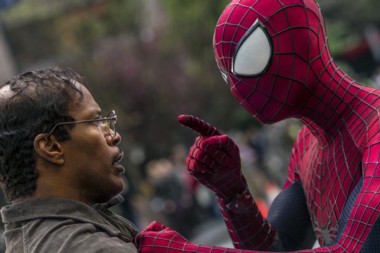Cinema as we know it today would be nothing without its heroes. For all the high-minded talk about its artistry—of dramatic chiaroscuro and delicate details, of symbolism and self-reference—our films still often boil down to that oldest sort of storytelling in which lone heroes stand against those who would do them (and us) harm. When they triumph, so do we.
It’s a sort of story that goes back at least as far as Homer’s Odyssey, and probably farther than that. This week, a few very different films come to area screens, each with its own version of the hero tale to tell. At first blush, they might not seem so connected—one star travels by chariot, another by web, while a third goes by miniature spaceship—but although the surroundings might change, the journey, largely, remains the same.
Kicking things off on Friday at Cinemark Theaters in Hadley is The Amazing Spider-Man 2, the second film in the recently rebooted series. (You can also catch an early screening Thursday at 7 p.m. if you’d like to beat the crowds.) Following up on the three earlier Spider-Man films by director Sam Raimi, the newer movies are helmed by Marc Webb, a director best known as the man behind a series of music videos and documentaries for some rather generic rock bands. But Webb’s pop-culture pedigree seems to have served him well, and his additions to the Spider-Man franchise have been well-received.
Here, Andrew Garfield (The Social Network) stars as the famous web-slinger, opposite Emma Stone as his love interest and Jamie Foxx as the villain Electro. In Webb’s films, Garfield’s Peter Parker is a bit less nerdy and a bit more of a hipster than Tobey Maguire was in the earlier films, and they take a slightly darker track. Nowhere is that more apparent than at the climax—an iconic moment familiar to fans of the comic series, it may come as a shock to those expecting a lighthearted conclusion.
On Sunday, the theater hosts a screening of the 1959 classic Ben-Hur. Starring Charlton Heston as the title character, the film is a Bible-era epic that broke budget and set design records in its day. Heston’s Judah Ben-Hur is a wealthy and respected citizen of Jerusalem who is betrayed by his old friend Messala, a Roman. Banished into slavery, Ben-Hur serves as a oarsman in a Roman flagship and a charioteer in their stadiums, eventually regaining his freedom and the wealth necessary to find his way back to his homeland. There, he confronts Messala and reunites with his lost family. Sharp-eyed viewers will note that Jesus also makes a cameo.
Also this week: Amherst Cinema screens the 1966 film Fantastic Voyage—in which a group of scientists is miniaturized and injected into the bloodstream of an ailing physicist—as part of its Science on Screen series, which pairs science-themed films with talks by local experts. Here, physicist Dr. Katherine Aidala of Mount Holyoke College will be on hand to discuss the history and possible futures of nanotechnology. The promise of nanotech, an idea often traced to a 1959 lecture by Richard Feynman, is that we could produce robots that would in turn create smaller and smaller robots, until we eventually reach a point where our robots are operating on an atomic level we could not function on ourselves. No word on whether the nanotechnology behind Raquel Welch’s suspiciously snug wardrobe for the film will be discussed.•
Jack Brown can be reached at cinemadope@gmail.com.



